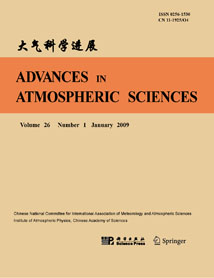| [1] |
Huizhen YU, Zhiyong MENG,
2022: The Impact of Moist Physics on the Sensitive Area Identification for Heavy Rainfall Associated Weather Systems, ADVANCES IN ATMOSPHERIC SCIENCES, 39, 684-696.
doi: 10.1007/s00376-021-0278-9
|
| [2] |
ZHOU Feifan, MU Mu,
2012: The Time and Regime Dependencies of Sensitive Areas for Tropical Cyclone Prediction Using the CNOP Method, ADVANCES IN ATMOSPHERIC SCIENCES, 29, 705-716.
doi: 10.1007/s00376-012-1174-0
|
| [3] |
ZHOU Feifan, MU Mu,
2012: The Impact of Horizontal Resolution on the CNOP and on Its Identified Sensitive Areas for Tropical Cyclone Predictions, ADVANCES IN ATMOSPHERIC SCIENCES, 29, 36-46.
doi: 10.1007/s00376-011-1003-x
|
| [4] |
CHEN Boyu, MU Mu,
2012: The Roles of Spatial Locations and Patterns of Initial Errors in the Uncertainties of Tropical Cyclone Forecasts, ADVANCES IN ATMOSPHERIC SCIENCES, 29, 63-78.
doi: 10.1007/s00376-011-0201-x
|
| [5] |
Xiangjun TIAN, Xiaobing FENG,
2019: An Adjoint-Free CNOP-4DVar Hybrid Method for Identifying Sensitive Areas in Targeted Observations: Method Formulation and Preliminary Evaluation, ADVANCES IN ATMOSPHERIC SCIENCES, , 721-732.
doi: 10.1007/s00376-019-9001-5
|
| [6] |
Qian ZHOU, Wansuo DUAN, Xu WANG, Xiang LI, Ziqing ZU,
2021: The Initial Errors in the Tropical Indian Ocean that Can Induce a Significant “Spring Predictability Barrier” for La Niña Events and Their Implication for Targeted Observations, ADVANCES IN ATMOSPHERIC SCIENCES, 38, 1566-1579.
doi: 10.1007/s00376-021-0427-1
|
| [7] |
Zexu Luo, Xiaoquan Song, Jiaping Yin, Zhichao Bu, Yubao Chen, Yongtao Yu, Zhenlu Zhang,
2024: Comparison and Verification of Coherent Doppler Wind Lidar and Radiosonde in Beijing Urban Area, ADVANCES IN ATMOSPHERIC SCIENCES.
doi: 10.1007/s00376-024-3240-9
|
| [8] |
S.S. Singh, S. S Vaidya, E. N. Rajagopal,
1990: A Limited Area Model for Monsoon Prediction, ADVANCES IN ATMOSPHERIC SCIENCES, 7, 111-126.
doi: 10.1007/BF02919174
|
| [9] |
Wang Yuan, Tan Zhemin,
2002: Monotonic Digit Filter for Limited-Area Model, ADVANCES IN ATMOSPHERIC SCIENCES, 19, 337-349.
doi: 10.1007/s00376-002-0026-8
|
| [10] |
Keon Tae SOHN, Jeong Hyeong LEE, Young Seuk CHO,
2009: Ternary Forecast of Heavy Snowfall in the Honam Area, Korea, ADVANCES IN ATMOSPHERIC SCIENCES, 26, 327-332.
doi: 10.1007/s00376-009-0327-2
|
| [11] |
Haochen LI, Chen YU, Jiangjiang XIA, Yingchun WANG, Jiang ZHU, Pingwen ZHANG,
2019: A Model Output Machine Learning Method for Grid Temperature Forecasts in the Beijing Area, ADVANCES IN ATMOSPHERIC SCIENCES, 36, 1156-1170.
doi: 10.1007/s00376-019-9023-z
|
| [12] |
Li Weiping, Theo Chidiezie Chineke, Liu Xin, Wu Guoxiong,
2001: Atmospheric Diabatic Heating and Summertime Circulation in Asia-Africa Area, ADVANCES IN ATMOSPHERIC SCIENCES, 18, 257-269.
doi: 10.1007/s00376-001-0018-0
|
| [13] |
Liu Huaqiang, Qian Yongfu, Zheng Yiqun,
2002: Effects of Nested Area Size upon Regional Climate Model Simulations, ADVANCES IN ATMOSPHERIC SCIENCES, 19, 111-120.
doi: 10.1007/s00376-002-0038-4
|
| [14] |
Moon-Soo PARK, Seung Jin JOO, Soon-Ung PARK,
2014: Carbon Dioxide Concentration and Flux in an Urban Residential Area in Seoul, Korea, ADVANCES IN ATMOSPHERIC SCIENCES, 31, 1101-1112.
doi: 10.1007/s00376-013-3168-y
|
| [15] |
Surachai SATHITKUNARAT, Prungchan WONGWISES, Rudklao PAN-ARAM, ZHANG Meigen,
2006: Carbon Monoxide Emission and Concentration Models for Chiang Mai Urban Area, ADVANCES IN ATMOSPHERIC SCIENCES, 23, 901-908.
doi: 10.1007/s00376-006-0901-9
|
| [16] |
Chen Longxun, Li Weiliang,
1985: THE ATMOSPHERIC HEAT BUDGET IN SUMMER OVER ASIA MONSOON AREA, ADVANCES IN ATMOSPHERIC SCIENCES, 2, 487-497.
doi: 10.1007/BF02678747
|
| [17] |
Qiu Jinhuan, Wang Kaixiang,
1993: A Study of the Radiation-Climate Effect of Aerosol over Beijing Area, ADVANCES IN ATMOSPHERIC SCIENCES, 10, 147-154.
doi: 10.1007/BF02919137
|
| [18] |
XU Jun, ZHANG Yuanhang, WANG Wei,
2006: Numerical Study on the Impacts of Heterogeneous Reactions on Ozone Formation in the Beijing Urban Area, ADVANCES IN ATMOSPHERIC SCIENCES, 23, 605-614.
doi: 10.1007/s00376-006-0605-1
|
| [19] |
LI Maoshan, MA Yaoming, MA Weiqiang, HU Zeyong, ISHIKAWA Hirohiko, Zhongbo SU, SUN Fanglin,
2006: Analysis of Turbulence Characteristics over the Northern Tibetan Plateau Area, ADVANCES IN ATMOSPHERIC SCIENCES, 23, 579-585.
doi: 10.1007/s00376-006-0579-z
|
| [20] |
Lei Xiao’en, Jia Xinyuan, Yuan Suzhen, Luo Qiren, Chen Silong, Xu Yu,
1987: A NUMERICAL SIMULATION OF THE DISTRIBUTION OF ACID PRECIPITATION IN CHONGQING AREA OF CHINA, ADVANCES IN ATMOSPHERIC SCIENCES, 4, 313-322.
doi: 10.1007/BF02663601
|















 AAS Website
AAS Website 
 AAS WeChat
AAS WeChat 
 DownLoad:
DownLoad: